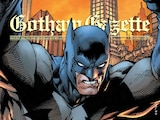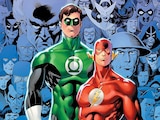DC Super Heroes are everywhere. Between blockbuster movies like The Batman and Wonder Woman to recent TV hits like The CW’s The Flash and HBO Max’s Peacemaker, viewers have become so superhero-aware that even obscure characters like Deathstorm, Vigilante and King Shark have become almost as well-known as Superman and Batman. What was before a sparse media landscape where tentpole superhero films seemed to arrive every decade or so has evolved into a geeky crash course for eager audiences, fascinated by the breadth of stories comic books can create that those other mediums cannot.
I say this with firsthand experience. By day I’m a mild-mannered bookseller, humbly directing enthusiastic new readers towards the original stories that shaped and inspired the films and shows that have captured their attention. It’s quite the experience to behold—a new fan’s excited curiosity over what character or story arrived when, who first appeared where, and whether certain characters died the same way in certain comics.
So why not indulge them a bit? Let’s take a look at some DC movies and TV shows and explore their relationships with the source material to better understand how things change for the characters between the two.
Original Characters

Many popular comic book characters debuted outside of comics and this is far from a recent phenomenon. Going all the way back to 1940, mainstay supporting characters such as Daily Planet Editor-in-Chief Perry White and Cub Reporter Jimmy Olsen were first properly introduced in The Adventures of Superman radio series. Although an unnamed editor (later called George Taylor) and office boy occupied White and Olsen’s roles in the Siegel and Shuster comic book series, the popularity of the radio show resulted in While and Olsen being brought to the comics. The two would go on to be signature supporting players in the Superman mythos, with Jimmy Olsen going so far as to have his own comic book series that lasted for nearly thirty years and over 200 issues!
Other popular examples can be found in the influential spate of DC animated series in the 1990s. Harley Quinn is the most popular example, originally featured as a modern “moll”-type character for the Joker in Batman: The Animated Series. Voiced by Arleen Sorkin, she quickly took on a life of her own, later featuring in episodes of Batman: The Animated Series without the Joker, hundreds of bestselling comics, an animated series of her own, and of course, a colorful big-screen portrayal by Margot Robbie.

The first but not the last, Harley can be viewed as a prototype for several original female characters created in ’90s animation. The character of Mercy Graves, the chauffer and bodyguard of Lex Luthor, originated in Superman: The Animated Series, as did Livewire—a new villain inspired by the era’s infatuation with shock jocks. By the end of the ’90s, Mercy was implemented in the DC Universe proper, while Livewire premiered in 2006’s Action Comics #835 by creators Gail Simone and John Byrne. Both have since made their way back to the screen—this time in live action.
Which Came First?

Some situations sit in a gray area of creation, though they’re no less fascinating. The character of Barbara Gordon a.k.a. Batgirl, for instance, premiered both in the comics and on the Batman TV show in 1967. So, where did she appear first?
In 1967, Batman executive producer William Dozier went to the DC offices to suggest a new Batgirl character, not caring for the blonde-haired version from the previous decade. This creation was intended to be the daughter of Commissioner Gordon, and more bat-like. This idea spawned a new design by classic DC artist Carmine Infantino, and the character debuted in the now classic “The Million Dollar Debut of Batgirl” in 1967’s Detective Comics #359. It wasn’t until after this that Yvonne Craig first brought her to life on Batman in the episode “Enter Batgirl, Exit Penguin.” So, Batgirl is truly as unique as the young Babs herself—a character who was originally made for the TV show, but still came first in the comics!

A similar occurrence happened over twenty-five years later with the character of Renee Montoya. Originally conceived by Bruce Timm, Paul Dini and Mitch Brian for Batman: The Animated Series, this uniformed GCPD cop was created to be a partner for Detective Harvey Bullock. She would first appear in the episode “P.O.V.” in September 1992 but premiered in the comics six months earlier in the pages of Batman #475 by writer Alan Grant and artist Norm Breyfogle.
Inspired Storylines

Some characters did better in media adaptations than they fared in the comics. For years, Mr. Freeze—originally called Mr. Zero—was a D-list Batman villain who never made more of an impact than your average Signalman or Stingaree. Even an appearance on the 1960s series did little to give him meaningful exposure beyond being just another one of the rogues.
This would all change in 1992 when the Batman: The Animated Series episode “Heart of Ice” presented Mr. Freeze as an emotionless, cold-blooded force of nature who sought revenge on his former boss. Through his investigation, Batman discovers Freeze’s origin as Dr. Victor Fries, who was experimenting with cryogenics in order to cure his wife Nora of a deadly illness when he was exposed to liquid nitrogen, mutating his body to subzero temperatures. Tragically, his wife was also lost in the explosion and Fries shifted his efforts from salvation to revenge.
Viewers immediately responded to this villain’s now-sympathetic backstory and were compelled to see how Batman contended with a man haunted by loss similar to his. They weren’t the only ones impressed by it. The episode earned the animated series an Emmy and was popular enough to influence the Dark Knight’s cinematic adventures at the time. In 1997’s Batman & Robin, Mr. Freeze’s backstory was adapted not from the comics, but from “Heart of Ice.” Eventually, even the comics themselves made a switch to Freeze’s animated origin and it’s remained canon to this day.
Exposure

Of all the ways that movies and TV have influenced DC comic books, one of the most important is better representation and diversity. For example, the Black Green Lantern John Stewart was created in the early 1970s. But it wasn’t until the 2000s, when the Justice League animated series used John Stewart as their sole Green Lantern, that he gained the recognition he deserved. For five seasons, John was given center stage, gaining his own rogues gallery, love interests and storylines that rocked the foundations of the League and the series.
There’s also the character of Cyborg, who was a member of the Teen Titans for many years. Thanks to the 2003 Teen Titans series and its later incarnation, Teen Titans Go!, many young fans saw this cybernetic hero as an important DC character on par with the likes of Robin. This popularity led to not only live action appearances in Smallville and Doom Patrol, but in 2011, Cyborg was made a flagship member of the Justice League, appearing in 2016’s (and 2021’s) Justice League as played by Ray Fisher.

Finally, we can’t neglect the recently relaunched Milestone. The comic Static was one of four Milestone titles that were initially published to provide some of the meaningful representation and diverse storytelling that wasn’t consistently found in mainstream books at the time. In 2000, Static was the focus of the animated series Static Shock, which for four seasons introduced young viewers to the supercharged teenage hero, his world and rogues. Static Shock was a popular series that ran for years, and Static himself later would be seen in the series Justice League Unlimited, which was co-executive produced by his co-creator Dwayne McDuffie. The recognition the character got from his animated appearances has cast a large shadow over his comics, with the recent Static: Season One serving as a wonderful blend of the original Milestone comic and the animated series.
Many more examples could be listed, from the ’70s Wonder Woman series to the 2014 Flash TV show. For most fans, it’s easier to watch a show or movie than to pick up a comic today. But that’s okay because as the past few decades have shown us, strong superhero storytelling has a way of rising to the top. Whether it begins on the screen or on the page, a good superhero idea is unlikely to stay there. In fact, you could say it’s the genre’s best superpower.
Donovan Morgan Grant writes about comics, graphic novels and superhero history for DCComics.com. Follow him on Twitter at @donoDMG1.
NOTE: The views and opinions expressed in this feature are solely those of Donovan Morgan Grant and do not necessarily reflect those of DC Entertainment or Warner Bros.















